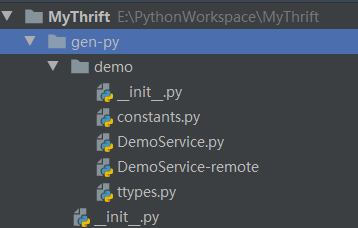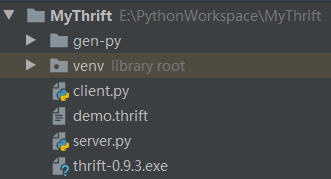这篇文章将为大家详细讲解有关python怎么实现Thrift服务端,小编觉得挺实用的,因此分享给大家做个参考,希望大家阅读完这篇文章后可以有所收获。
python可以做什么
Python是一种编程语言,内置了许多有效的工具,Python几乎无所不能,该语言通俗易懂、容易入门、功能强大,在许多领域中都有广泛的应用,例如最热门的大数据分析,人工智能,Web开发等。
环境准备
根据自身实际情况下载对应的Thrift编译器,比如我在Windows系统上使用的是thrift-0.9.3.exe 。下载地址:http://archive.apache.org/dist/thrift/
python安装thrift库:pip install thrift
编写.thrift文件
.thrift文件定义了Thrift服务端和Thrift客户端的通信接口,在该文件中定义的接口需由服务端实现,并可被客户端调用。Thrift编译器会调用.thrift文件生成不同语言的thrift代码,用于之后实现thrift服务端或thrift客户端。
.thrift文件的编写规则可参考Thrift白皮书。下面将以demo.thrift文件举例
service DemoService{ string ping(1:string param) map<i32,string> get_int_string_mapping_result(1:i32 key, 2:string value) bool get_bool_result()}生成python对应的thrift代码
使用以下命令可以生成不同语言的thrift代码:
thrift --gen <language> <Thrift filename>
通过thrift-0.9.3.exe --gen py demo.thrift 命令生成python版本的thrift文件,文件夹为gen-py,如下所示:

编写服务端
编写服务端server.py,用于实现在demo.thrift文件中定义的接口功能。
from thrift.transport import TSocketfrom thrift.transport import TTransportfrom thrift.protocol import TBinaryProtocolfrom thrift.server import TServerimport syssys.path.append("./gen-py/")from demo import DemoServiceimport randomclass DemoServer: def __init__(self): self.log = {} def ping(self, param): return "echo:" + param def get_int_string_mapping_result(self, key, value): return {key: value} def get_bool_result(self): return random.choice([True, False])if __name__ == '__main__': # 创建处理器 handler = DemoServer() processor = DemoService.Processor(handler) # 监听端口 transport = TSocket.TServerSocket(host="0.0.0.0", port=9999) # 选择传输层 tfactory = TTransport.TBufferedTransportFactory() # 选择传输协议 pfactory = TBinaryProtocol.TBinaryProtocolFactory() # 创建服务端 server = TServer.TThreadPoolServer(processor, transport, tfactory, pfactory) # 设置连接线程池数量 server.setNumThreads(5) # 启动服务 server.serve()编写客户端用于测试
编写客户端client.py,用于测试服务端功能是否可用。
from thrift import Thriftfrom thrift.transport import TSocketfrom thrift.transport import TTransportfrom thrift.protocol import TBinaryProtocolimport syssys.path.append("./gen-py/")from demo import DemoServiceif __name__ == '__main__': transport = TSocket.TSocket('127.0.0.1', 9999) transport = TTransport.TBufferedTransport(transport) protocol = TBinaryProtocol.TBinaryProtocol(transport) client = DemoService.Client(protocol) # 连接服务端 transport.open() recv = client.ping("test") print(recv) recv = client.get_int_string_mapping_result(10, "MyThrift") print(recv) recv = client.get_bool_result() print(recv) # 断连服务端 transport.close()编写完成后,整个项目结构如下图所示:

测试服务端
运行服务端server.py后,运行客户端client.py,打印的内容如下:
echo:test{10: 'MyThrift'}True此时客户端能够正常调用服务端所提供的接口。(PS:在调试过程中,也许需要修改gen-py文件夹中Thrift编译器生成的python代码)
关于“python怎么实现Thrift服务端”这篇文章就分享到这里了,希望以上内容可以对大家有一定的帮助,使各位可以学到更多知识,如果觉得文章不错,请把它分享出去让更多的人看到。






